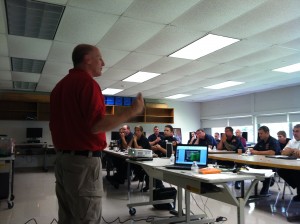
Columbus, OH Fireman Bill Brobst (in red) instructs area first responders during an ethanol training course put on by the Renewable Fuels Association Wednesday (Photo: Peter Francis)
WESTFIELD – In order to keep the public as safe as possible, firefighters all over America must stay sharp with training and certification.
First responders from the Westfield Fire Department, along with several other volunteer departments which receive mutual aid from the city, were at South Middle School Wednesday to take a safety course on ethanol-related fires.
Ethanol, or ethyl-alcohol, is a highly-flammable, colorless liquid made from corn that has become a common biofuel additive to gasoline.
“We teach first responders how to handle incidents involving ethanol and ethanol-blended fuels,” said Bill Brobst, a firefighter from Columbus, Ohio who has been traveling the country conducting ethanol seminars with his wife Cheryl as representatives for the Renewable Fuels Association (RFA), a trade organization based out of Washington D.C.
“Since it’s now in about 98 percent of our gasoline, (this class) helps them to change their attitudes about dealing with gasoline products as we have in the past,” said Brobst. “Now, how does the fact that we have ethanol in the fuel really change the fuel’s properties? How do you have change how you respond to it?”
Brobst stated that incidents involving railcars, over-the-road trucks, and other automobiles are the common instances when fires involving ethanol may arise for first response.
He also shared a wide array of scenarios and how to react when ethanol blends with water, a worst case scenario for first responders.
“If we are dealing with alcohol and gasoline and there’s no water, the things we’ve done in the past will continue to work,” Brobst said. “Ethanol is very happy with gasoline, and it will stay mixed until I get water involved with it.”
“If it mixes with water, the water will draw the ethanol out of the mixture, and what you’ll end up with is gasoline floating on top and a water-ethanol mixture floating below it,” Brobst said, adding that ethanol can cause environmental hazards if it is released into a body of water. “By EPA (Environmental Protection Agency) standards, the best thing you can do sometimes is to let it (ethanol) burn. Sometimes, if it ain’t hurting anything, let it burn.”
The four-hour lecture course was offered on Tuesday and Wednesday at South Middle School and concluded with first responders receiving certificates of completion and a package that trainers for individual fire departments can use to train firefighters in the future.
“We give participant and instructor’s manuals and all the videos they need,” Brobst said before readying the group of 20 or so first responders for the final leg of the lecture session.
“It’s on a federal grant through the federal railroad administration plus TransCare,” he said of the course. “We notify (departments) that we’ll be in the area and if they want to sponsor it, we put out that information and advertise the class in a variety of ways.”
“It’s a really good class. We do definitely have an exposure in town with the railroad going through, so it’s something we definitely needed,” said Westfield Fire Captain Seth Ellis. “We appreciate the RFA reaching out to us and setting this up.”
Ellis attended both sessions and said that first responders came from across western Mass. to increase their knowledge.
“Yesterday I think we had around 31 and today we had around 20-ish,” he said. “I know the RFA put out information to some places, I know we put out information to some surrounding mutual aid partners, so I know we had Huntington, Chester (fire departments). We sent some stuff to the State Chief’s Association, and as far as the Lee Police Department. So a lot of partners from the area and the wider region.”

